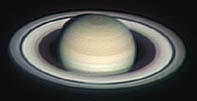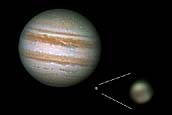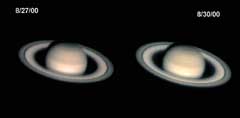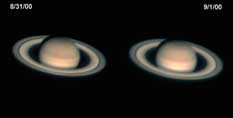Solar System Images
Although light
pollution is not a problem for planetary imaging, the
Atmosphere must be very steady to obtain sub-arc second
resolution. Near the gulf coast, the skies are not very
transparent but at times the steadiness of the atmosphere
can be very good. This usually occurs during the summer
when laminar flow off the gulf saturates the air and the
temperature is near the dew point. At this time the
thermal inertia of the atmosphere is at its maximum and
convection currents are at their minimum.



 The Ringed Planet Saturn. These images of Saturn were taken with a C14
and a ST6 CCD. Eyepiece projection was used with a 10mm
plossel to increase the focal ratio to f/66. These images were
taken 9/15/01, 9/16/01, 9/19/01 and 9/20/01 from Houston
Texas.
The Ringed Planet Saturn. These images of Saturn were taken with a C14
and a ST6 CCD. Eyepiece projection was used with a 10mm
plossel to increase the focal ratio to f/66. These images were
taken 9/15/01, 9/16/01, 9/19/01 and 9/20/01 from Houston
Texas.
 High Resolution Planetary
Imaging. Many times it
is nearly impossible for one to take advantage of the full
resolution that a scope can provide. There are many factors
that have to come together at one tine to get the highest
possible resolution. A good CCD, fine optics and excellent
tracking are necessary from the equipment side. Many times,
good telescopes can be collimated poorly, not letting their
optics perform at there best. One of the most difficult
aspects of planetary imaging is getting good focus. It usually
takes me about 20-30 minutes before I have convinced myself
that the focus is as good as it can be. The wild card in the
process is the atmospheric seeing. Here on the Gulf Coast of
the USA, the seeing fairly often is 7-8 and sometimes it
approaches 9 momentarily. High resolution imaging can be
attempted when the seeing approaches 8 while hoping for
moments of better seeing during the actual exposures. These
images of Jupiter were taken with a C14 and a ST6 CCD on
10/20/00 and 10/19/00 from Houston, Texas.
High Resolution Planetary
Imaging. Many times it
is nearly impossible for one to take advantage of the full
resolution that a scope can provide. There are many factors
that have to come together at one tine to get the highest
possible resolution. A good CCD, fine optics and excellent
tracking are necessary from the equipment side. Many times,
good telescopes can be collimated poorly, not letting their
optics perform at there best. One of the most difficult
aspects of planetary imaging is getting good focus. It usually
takes me about 20-30 minutes before I have convinced myself
that the focus is as good as it can be. The wild card in the
process is the atmospheric seeing. Here on the Gulf Coast of
the USA, the seeing fairly often is 7-8 and sometimes it
approaches 9 momentarily. High resolution imaging can be
attempted when the seeing approaches 8 while hoping for
moments of better seeing during the actual exposures. These
images of Jupiter were taken with a C14 and a ST6 CCD on
10/20/00 and 10/19/00 from Houston, Texas.
 Jupiter's White Ovals.
One of the atmospheric
phenomenon on Jupiter is the occurrence of white ovals. These
"storms" appear and dissipate sometimes lasting years. The
white ovals drift over time and have the possibility of
colliding with one another. A collision of white ovals is of
scientific interest as much can be learned about the
atmospheric dynamics from such an event. Antonio Cidadao has noticed over the last few weeks that the
two on the left seem to be moving closer together. The moon to
the right is Io. The white ovals should be visible in a 6 inch
refractor or an 8 inch reflector and can be monitored to see
if a collision will take place. This image was taken from
Houston Texas with a ST6 CCD and a C14 @ f/62 on 1/23/01.
Jupiter's White Ovals.
One of the atmospheric
phenomenon on Jupiter is the occurrence of white ovals. These
"storms" appear and dissipate sometimes lasting years. The
white ovals drift over time and have the possibility of
colliding with one another. A collision of white ovals is of
scientific interest as much can be learned about the
atmospheric dynamics from such an event. Antonio Cidadao has noticed over the last few weeks that the
two on the left seem to be moving closer together. The moon to
the right is Io. The white ovals should be visible in a 6 inch
refractor or an 8 inch reflector and can be monitored to see
if a collision will take place. This image was taken from
Houston Texas with a ST6 CCD and a C14 @ f/62 on 1/23/01.




The Many Faces of
Jupiter. Jupiter
continuously displays a different view of itself. From the
cloud belts, to the red spot, to the moons of Jupiter which
regularly cast their shadows on the cloud tops of Jupiter, the
face of Jupiter is always changing. In the second image Io's
shadow can be seen as a dark circle on Jupiter. Io itself can
be seen as a small dot just to the right of Jupiter's Red
Spot. Ganymede can be seen in the third image. These images
are LRGBs taken with a C14 and a ST6 CCD operating at a focal
ratio of f/65 through 10mm eyepiece projection. Taken from
Houston, Texas in September and October 2000.





The Planet Jupiter. The planet Jupiter is the largest planet in
the solar system. It is a "gas giant" and this year it is
almost 50 arc seconds in apparent diameter. Jupiter is
actually about 88,000 miles in diameter and is about 500
million miles from the sun. Its rapid rotation( 10 hour day)
and large gaseous mass flattens out Jupiter so that its
equatorial diameter is greater than its polar diameter. The
grey scale image was made from the average of 8 images each .4
seconds. Taken with a C14 and a ST6 CCD from Houston, Texas on
11/13/99 using a 10mm projection eyepiece. The left 3 color
images were made with the same configuration on 11/22/99 and
the right hand image was taken 11/27/99.
 Jupiter and it's Red Spot. The red spot on Jupiter is a giant "storm"
that has existed for hundreds of years. It can be observed
with a small telescope of about 4 inches. Since Jupiter has a
rapid rotation period of about 10 hours, the red spot makes a
regular appearance. This image of Jupiter was made with a ST6
CCD and a C14 at f/65. A 12 mm eyepiece was used to project
the image 85mm onto the CCD chip. This LRGB was taken 10/6/00
from Houston Texas. Exposure times were R=G=B=.2 seconds.
Jupiter and it's Red Spot. The red spot on Jupiter is a giant "storm"
that has existed for hundreds of years. It can be observed
with a small telescope of about 4 inches. Since Jupiter has a
rapid rotation period of about 10 hours, the red spot makes a
regular appearance. This image of Jupiter was made with a ST6
CCD and a C14 at f/65. A 12 mm eyepiece was used to project
the image 85mm onto the CCD chip. This LRGB was taken 10/6/00
from Houston Texas. Exposure times were R=G=B=.2 seconds.

 The planet Saturn. Saturn has the distinction of having a
spectacular ring system. The rings may be viewed in a small
60mm scope with a minimum of about 40 power. In a 4 to 6 inch
scope, Cassini's division can be seen as a gap between the two
primary rings. The diameter of the ring system is 171,000
miles. Although the rings appear to be solid, background stars
can be seen shining through the ring system. This image is a
WCMY made with a C14 and an ST5 CCD taken from Houston, Texas
on 9/19/98.
The planet Saturn. Saturn has the distinction of having a
spectacular ring system. The rings may be viewed in a small
60mm scope with a minimum of about 40 power. In a 4 to 6 inch
scope, Cassini's division can be seen as a gap between the two
primary rings. The diameter of the ring system is 171,000
miles. Although the rings appear to be solid, background stars
can be seen shining through the ring system. This image is a
WCMY made with a C14 and an ST5 CCD taken from Houston, Texas
on 9/19/98.

 The
Ringed Planet Saturn. The
planet Saturn has the distinction of the planet with the most
beautiful ring system. Although the rings appear solid they
are actually made up of many small pieces. The rings shape is
governed by Saturn's moons. These moons are called
"shepherding" satellites and have molded the rings as we see
them today. Saturn is the second largest planet of the solar
system and is known as a "gas giant". These images of Saturn
are "LRGB" taken with a C14 at f/22 using a 10 mm projection
eyepiece and a ST237 CCD. Taken from Houston Texas from
8/27/00-9/1/00.
The
Ringed Planet Saturn. The
planet Saturn has the distinction of the planet with the most
beautiful ring system. Although the rings appear solid they
are actually made up of many small pieces. The rings shape is
governed by Saturn's moons. These moons are called
"shepherding" satellites and have molded the rings as we see
them today. Saturn is the second largest planet of the solar
system and is known as a "gas giant". These images of Saturn
are "LRGB" taken with a C14 at f/22 using a 10 mm projection
eyepiece and a ST237 CCD. Taken from Houston Texas from
8/27/00-9/1/00.

The Planet Jupiter. The planet Jupiter is the largest planet in
the solar system. It is a "gas giant" and this year it is
almost 50 arc seconds in apparent diameter. Jupiter is
actually about 88,000 miles in diameter and is about 500
million miles from the sun. Its rapid rotation( 10 hour day)
and large gaseous mass flattens out Jupiter so that its
equatorial diameter is greater than its polar diameter. Taken
with a C14 and a ST6 CCD from Houston, Texas using a 10mm
eyepiece projection to f/65. This image was taken 11/27/99.
 The Crater Clavius on the Moon. Clavius can be seen as the large crater on
the left side of this image. close examination reveals many
small craters on the floor of Clavius and a curious partial
ring of larger craters. Look for Clavius about 2 days after
half moon. This image was taken with a C14 at f/11 with a
st237 CCD on 4/12/00 from Houston Texas. Exposure time was .03
seconds.
The Crater Clavius on the Moon. Clavius can be seen as the large crater on
the left side of this image. close examination reveals many
small craters on the floor of Clavius and a curious partial
ring of larger craters. Look for Clavius about 2 days after
half moon. This image was taken with a C14 at f/11 with a
st237 CCD on 4/12/00 from Houston Texas. Exposure time was .03
seconds.
 Comet
Hale-Bopp...4/05/97...50mm...@f/5.6...50sec... from Danciger,
Tx.
Comet
Hale-Bopp...4/05/97...50mm...@f/5.6...50sec... from Danciger,
Tx.



 The Ringed Planet Saturn. These images of Saturn were taken with a C14
and a ST6 CCD. Eyepiece projection was used with a 10mm
plossel to increase the focal ratio to f/66. These images were
taken 9/15/01, 9/16/01, 9/19/01 and 9/20/01 from Houston
Texas.
The Ringed Planet Saturn. These images of Saturn were taken with a C14
and a ST6 CCD. Eyepiece projection was used with a 10mm
plossel to increase the focal ratio to f/66. These images were
taken 9/15/01, 9/16/01, 9/19/01 and 9/20/01 from Houston
Texas.
















